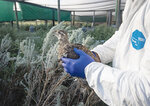Clear, 66° F
A plan to release pen-raised greater sage grouse into the wild by Upland Hills, LLC (formerly a division of Diamond Wings Upland Game Birds) has been approved by the Wyoming Game and Fish Department; …
This item is available in full to subscribers.
The Powell Tribune has expanded its online content. To continue reading, you will need to either log in to your subscriber account, or purchase a subscription.
If you are a current print subscriber, you can set up a free web account by clicking here.
If you already have a web account, but need to reset it, you can do so by clicking here.
If you would like to purchase a subscription click here.
Please log in to continue |
|



A plan to release pen-raised greater sage grouse into the wild by Upland Hills, LLC (formerly a division of Diamond Wings Upland Game Birds) has been approved by the Wyoming Game and Fish Department; the first time the species raised and bred in captivity have been approved for release in the state.
“The slated release plan is part of a collaborative research project with Utah State, the International Order of T. Roosevelt (IOTR) and Upland Hills (formerly known as Diamond Wings) to study the successes and failures of captive-raised birds that are released,” said department Public Information Officer Breanna Ball in an email exchange.
Upland Hills, solely owned and operated by Park County resident Karl Bear, is the only state-certified sage grouse farm in Wyoming and the only private entity currently raising the species of concern in the U.S. Bear purchased the grouse breeding facility last year from oil entrepreneur Dennis Brabec, who bought the facility that also raises game birds for hunting from former state Sen. Diemer True. Bear has managed the business for years and is the only person certified by the state in the application process.
Bear has extensive experience breeding and raising game birds, which the company will continue to do at a separate location under the Diamond Wings monicker. The company raises and sells tens of thousands of upland game birds across the West. Bear was previously an administrator at Northwest College before quitting to run the game bird farm full-time. He has been working on the sage grouse project since 2004, long attempting to convince state wildlife managers and legislators the bird could be raised in captivity and possibly be “a tool in the tool belt” in efforts to conserve the species, Bear said.
Wyoming has the most greater sage grouse and the largest amount of habitat in the world for the chicken-sized grouse with flamboyant mating rituals.
Upland Hills is looking to team up with Dave Dahlgren, assistant professor at the Department of Wildland Resources at Utah State University, IOTR and the Meeteetse Conservation District on the release plans. The company had originally looked at beginning the release this September, but Bear said they are in no hurry and have tentatively rescheduled the plans for next summer.
“My goal is to raise healthy, wild young birds capable of being released at a time when they would have their optimum chance to survive,” Bear said last week during an interview with the Tribune.
While Bear has been active in every aspect of raising and breeding the birds, he is taking a back seat in release plans to concentrate on raising chicks capable of surviving in the wild, he said. The plan is to release birds that are about 7 weeks old but appear to be almost full-grown.
Bear captured a 7-week old-chick in one of the many pens dedicated to the species to show the size of the chicks planned to be released.
“Next year it is our goal to release chicks of this size,” he said while holding the plump bird in his hands. “When you say chicks, you don't think of a bird this size.”
The plan is continuing to perfect hatching and rearing of the bird so a chick being “rewilded” has been kept on a natural diet and hasn't had time to imprint to humans, he said.
Dahlgren and officials from IOTR will be conducting the release, Bear said, as well as surveillance and research after the release. Dahlgren teaches wildlife habitat and ecosystem management and has worked on conservation plans for several species of grouse, including here in Wyoming.
“[Dahlgren’s] credibility has helped a ton,” Bear said. “He's well respected in the sage grouse world.”
Any release of captive sage grouse must comply with provisions set forth by the Game and Fish Commission's Chapter 60 regulation, Ball specified. According to the regulations, release of sage grouse and release methods shall only be permitted through coordination with the department and the commission may restrict areas of the state from sage grouse release to protect wild populations of sage grouse.
Seven years ago there were still some doubts Bear could raise a viable brood stock that would breed in captivity. But now Upland Hills has three generations of greater sage grouse that have been bred in the sprawling collection of incubation facilities and pens just outside Bear’s front door. There are currently 163 sage grouse in the brood, Bear said; all bred from the original 133 wild eggs collected in 2021.
The legislation that opened the breeding program to private enterprises was set to end due to a sunset law at the end of 2022, but the Legislature granted the experiment five more years before it is set to expire. Later that year Bear was given the sole right to raise greater sage grouse in the state by the Wyoming Game and Fish Commission. While the law initially called for a maximum of five certifications, Upland Hills (Diamond Wings at the time) was the only company to apply with the state and receive certification.
Bear knows news of a release will stir up a heated debate with conservation organizations and activists who opposed the plan from day one.
“It's very controversial,” Bear said. “Just making a statement is probably going to create a lot of arguments.”
Opponents of the law said they were afraid of pen-raised grouse placing wild populations at risk due to disease concerns. The Wyoming Legislature was cognizant of the need to protect existing wild populations of sage grouse from the threats posed by the release of pen-raised birds when the bird farm was first certified by the state in 2017. Wyoming Game and Fish Commission rules may restrict areas of release as necessary to protect existing wild populations of greater sage grouse.
The National Audubon Society Rockies chapter recommended that the rule prohibit the release of pen-raised birds in areas currently supporting populations of sage grouse as the legislation was debated.
“The release of birds should only be permitted in areas of the state that are completely devoid of wild greater sage grouse; e.g., areas where the birds have been locally extirpated,” the organization stated years before Bear was even allowed to collect wild eggs.
Bear has been working on the project since 2004. Despite being unable to monetize, the program has remained dedicated to raising the bird that was considered for listing for protections under the Endangered Species Act as recently as 2015.
Sage grouse hunting changes in 2024
Starting this year, all licensed sage grouse hunters will be required to carry a free, annual sage grouse hunting permit. This new regulation aims to enhance the Wyoming Game and Fish Department’s efforts to survey sage grouse hunters and gather valuable data on their hunting experiences.
All licensed sage grouse hunters must carry the permit alongside their game bird license. This requirement applies to daily, annual, lifetime and pioneer license holders. Wyoming hunters under the age of 14 are exempt from needing the permit as they do not require a license to hunt game birds. However, nonresident hunters under the age of 14 who purchase a game bird license and take their own limit will need a sage grouse permit. Falconers hunting sage grouse must possess the sage grouse permit and their falconry and game bird licenses.
“Wyoming has about 60,000 game bird license holders each year, with only a few thousand estimated to hunt sage grouse,” said Nyssa Whitford, Game and Fish sage-grouse/sagebrush biologist. “The new annual permit system will allow Game and Fish to send targeted surveys to sage grouse hunters, ensuring more accurate and timely data to aid in the management of this iconic species.”
The sage grouse permit can be acquired at Game and Fish offices or online through the department’s website. It can be obtained as a paper copy or electronically via a mobile device. A screenshot or downloaded PDF of the permit on a mobile device is acceptable in the field. The permit will not be available at license selling agents.